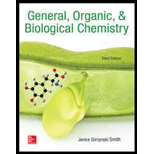
Concept explainers
(a)
Interpretation:
The functional group that is present in A but missing in B should be determined.
Concept Introduction:
(b)
Interpretation:
The new functional group that is present in B should be determined.
Concept Introduction:
Functional groups are the groups of atoms or atoms which are bonded with parent carbon chain in the organic molecule and are responsible for the physical and chemical properties of the compound. In organic chemistry, there are different functional groups such as carboxylic acid, alcohol, ester, or amide.
Want to see the full answer?
Check out a sample textbook solution
Chapter 17 Solutions
General, Organic, & Biological Chemistry
- 27. Which of the following statements about cholesterol is not correct? CH3 CH3 H. d но Cholesterol (a) Cholesterol is a steroid that contains a tetracyclic ring system. (b) Cholesterol is a steroid that contains 8 chiral carbons and can form 28 or 256 stereoisomers. (c) Each atom or group attached to a ring-junction carbon (i.e., carbons a -e) is in a trans or axial position. Because of this the tetracyclic ring system is mostly flat. (d) Cholesterol is used to synthesized vitamin D, bile acids, sex hormones, and adrenocorticoid hormones. (e) Cholesterol is not found in the cell membranes of animals.arrow_forwardIn glycoside formation, the hemiacetal functional group of a cyclic monosaccharide is converted to an acetal group by reaction with a(an)arrow_forwardDraw the structure of an example of each of the following types of lipids: (d) a soap (e) a detergentarrow_forward
- 14. (a) Identify the acetal and the ketal group in the following disaccharide. (b) Decide whether the compound is a non-reducing or reducing sugar. OH НО HƠ HO Н HO Н НО HO 15. (a) Identify the glycosidic bond in the following disaccharide. (b) Decide whether the compound is a non-reducing or reducing sugar. (c) Polysaccharide units are usually bonded together with a or B 1, 6 or 1, 4 linkages. What linkage is used in the disaccharide shown below? s) НО НО НО HO НО -OH OH -H OH CH2OH 16. Draw the structure for 1,4-B-D-galactopyranosyl-D-glucose. ( но- 17. Assign an R/S designation to each chirality center in the following compound: ( CHO НО -OHarrow_forwardThis substance, produced by certain soil bacteria as a defensive weapon, is used as an antibiotic. It is derived from monosaccharides. CH3 H NH₂ H₂N CH3 OH HO NH₂ CH3 NH -CH3 OH (a) How many "monosaccharide" residues are present? (b) List one way that these residues differ chemically from the monosaccharides you have I seen so far. (c) Draw an arrow pointing to one glycosidic bond. (d) Can you tell whether the bonds linking the residues have the alpha or beta configuration?arrow_forward(i) Which one of the following is a polysaccharide :Starch, Maltose, Fructose, Glucose?(ii) What one difference between a-helix and P-pleated sheet structure of protein.(iii) Write the name of the disease caused by the deficiency of Vitamin B12.arrow_forward
- Crocin, which occurs naturally in crocus and gardenia owers, is primarily responsible for the color of saffron. (a) What lipid and monosaccharides are formed by the hydrolysis of crocin? (b) Classify the lipid as a monoterpenoid, diperpenoid, etc., and locate the isoprene units.arrow_forward(g) Identify a simple lipid the list of compounds shown. ____________(h) Identify a complex lipid from the list of compounds shown. ____________(i) Identify a zwitterion from the list of compounds shown. ____________(j) Identify a lipid that is a constituent of cell membranes. ____________ write n/a if nonearrow_forwardCrocin, which occurs naturally in crocus and gardenia flowers, is primarily responsible for the color of saffron. (a) What lipid and monosaccharides are formed by the hydrolysis of crocin? (b) Classify the lipid as a monoterpenoid, diperpenoid, etc., and locate the isoprene units.arrow_forward
- does structure E represent fructofuranose? explainarrow_forwardA) Explain the differences between the following: (a) Aldoses and ketoses (b) Reducing sugars and non-reducing sugars. B) Discuss the significance of anomeric carbon in carbohydrates. C) Explain the differences between globular and fibrous proteins. D) Explain the changes in the secondary and tertiary structure of proteins for the following: (a) Milk is heated at 60°C to make yogurt. (b) Prior to giving an injection, the skin is wiped with an alcohol swab.arrow_forward(a) Draw the condensed structural formula, and give the name for the dipeptide Pro-Asn. (b) Draw the disaccharide formed by the following two monosaccharide via 1,4-linkage. In your disaccharide structure, circle and label the anomeric carbon and indicate whether you have an alpha (a) or a beta (B) anomer. CH2OH CH₂OH ОН ОН ОН ОН, ОН ОН ОН ОНarrow_forward

 Introduction to General, Organic and BiochemistryChemistryISBN:9781285869759Author:Frederick A. Bettelheim, William H. Brown, Mary K. Campbell, Shawn O. Farrell, Omar TorresPublisher:Cengage Learning
Introduction to General, Organic and BiochemistryChemistryISBN:9781285869759Author:Frederick A. Bettelheim, William H. Brown, Mary K. Campbell, Shawn O. Farrell, Omar TorresPublisher:Cengage Learning Organic ChemistryChemistryISBN:9781305580350Author:William H. Brown, Brent L. Iverson, Eric Anslyn, Christopher S. FootePublisher:Cengage Learning
Organic ChemistryChemistryISBN:9781305580350Author:William H. Brown, Brent L. Iverson, Eric Anslyn, Christopher S. FootePublisher:Cengage Learning


